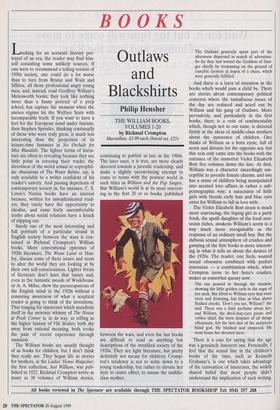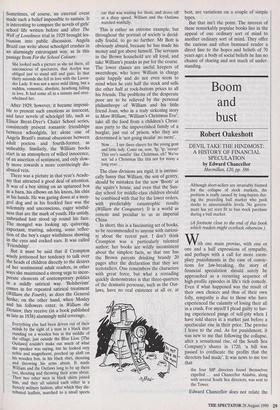BOOKS
Outlaws and Blackshirts
Philip Hensher
THE WILLIAM BOOKS, VOLUMES 1-20 by Richmal Crompton Macmillan, £3.99 each (boxed set, f25) Looking for an accurate literary por- trayal of an era, the reader may find him- self consulting some unlikely sources. If one were to recommend a telling version of 1950s society, one could do a lot worse than to turn from Braine and Wain and Sillitoe, all those professional angry young men, and, instead, read Geoffrey Willans's Molesworth books; they look like nothing more than a funny portrait of a prep school, but capture the moment when the ancien regime hit the Welfare State with incomparable truth. If you want to have a feel for the European mind under fascism, then Stephen Spender, thinking continually of those who were truly great, is much less interesting than the projection of its leisure-time fantasies in No Orchids for Miss Blandish. The lighter forms of litera- ture are often so revealing because they see little point in covering their tracks; the directness of the weird sexual or coprophil- iac obsessions of The Water Babies, say, is only available to a writer confident of his reader's naivety. And passing depictions of contemporary society in, for instance, C. S. Lewis's Narnia books have an interest because, written for unsophisticated read- ers, they rarely have the opportunity to idealise, and some fairly uncomfortable truths about social relations have a knack of slipping out.
Surely one of the most interesting and full portraits of a particular strand in English society between the wars is con- tained in Richmal Crompton's William books. More conventional epitomes of 1920s literature, The Waste Land or Hux- ley, discuss some of these issues and seem to alter the world they are looking at by their own self-consciousness. Lighter forms of literature don't have that luxury and, even in the fantastic moods of Wodehouse or A. A. Milne, show the preoccupations of the English mind in the 1920s without a censoring awareness of what a sceptical reader is going to think of the inventions. That longing for innocence which manifests itself in the moronic whimsy of The House at Pooh Corner is, in its way, as telling as the higher fantasy of Vile Bodies; both shy away from rational meaning, both evoke the pain of recent experience through omission.
The William books are usually thought of as books for children, but I don't think they really are. They began life as stories for mothers, in the Ladies' Home Magazine; the first collection, Just William, was pub- lished in 1922. Richmal Crompton wrote as many as 38 volumes of William stories, continuing to publish as late as the 1960s. The later ones, it is true, are more clearly directed towards a juvenile readership, and make a slightly unconvincing attempt to come to terms with the postwar world in such titles as William and the Pop Singers. But William's world is at its most interest- ing in the first 20 or so books, published between the wars, and even the last books are difficult to read as anything but descriptions of the stratified society of the 1920s. They are light literature, but pretty definitely not meant for children; Cromp- ton's tendency is not to write down to a young readership, but rather to elevate her style to comic effect, to amuse the middle- class mother.,
The Outlaws generally spent part of the afternoon dispersed in search of adventure. So far they had wooed the Goddess of Dan- ger chiefly by trespassing on the ground of irascible farmers in hopes of a chase, which were generally fulfilled.
And there is a layer of intention in the books which would pass a child by. There are stories about contemporary political concerns where the tumultuous issues of the day are reduced and acted out by William and his gang of Outlaws. More pervasively, and particularly in the first books, there is a vein of sentimentality which, though not to our taste, is directed firmly at the ideas of middle-class mothers about the innocence of children. One thinks of William as a born cynic, full of scorn and distaste for the opposite sex, but this vein only came into the books with the entrance of the immortal Violet Elizabeth Bott five volumes down the line. At first, William was a character exceedingly sus- ceptible to juvenile female charms, and one has a sense of children being manipulated into scented love affairs in rather a sub- pornographic way; a succession of little girls with blonde curly hair and blue eyes enter for William to fall in love with.
The Violet Elizabeth Bott strain is much more convincing; the lisping girl in a party frock, the spoilt daughter of the local nou- veaux riches, awakens William's scorn in a way much more recognisable as the response of an ordinary small boy. But the dubious sexual atmosphere of crushes and gawping of the first books is more interest- ing in what it tells us about the desires of the 1920s. The reader, one feels, wanted sexual obsession combined with perfect innocence — a combination which, when Crompton turns to her hero's crushes, makes us somewhat queasy now:
The sun poured in through the window, showing the little golden curls in the nape of her neck. She lifted to William eyes that were stern and frowning, but blue as blue above flushed cheeks. 'Don't you see, William?' she said. There was a faint perfume about her, and William, the devil-may-care pirate and robber chief, the stern despiser of all things effeminate, felt the first dart of the malicious blind god. He blushed and simpered. He went home her devoted slave.
There is a case for saying that the age was a genuinely innocent one. Personally, I feel that the sexual line in the children's books of the time, such as Kenneth Grahame's, is one which takes advantage of the convention of innocence, the widely shared belief that most people didn't understand the implication of such writing. Sometimes, of course, an external event made such a belief impossible to sustain. It is interesting to compare the novels of girls' school life written before and after The Well of Loneliness trial in 1929 brought les- bianism into public discussion. Angela Brazil can write about schoolgirl crushes in an alarmingly extravagant way, as in this passage from For the School Colours:
She looked such a picture as she sat there, all unconscious of spectators, that Avelyn was obliged just to stand still and gaze. In that thirty seconds she fell in love with the Laven- der Lady. It was not a mere mild liking, but a sudden, romantic, absolute, headlong falling in love. It had come all in a minute and over- whelmed her.
After 1929, however, it became impossi- ble to present such emotions as innocent, and later novels of schoolgirl life, such as Elinor Brent-Dyer's Chalet School series, consistently present romantic friendships between schoolgirls, let alone one of Angela Brazil's mutual obsessions between adult poetess and fourth-former, as unhealthy. Similarly, the William books start in an atmosphere of willed innocence, of an assertion of sentiment, and only slow- ly move towards a more convincingly dis- abused vein.
There was a picture in that year's Acade- my that attracted a good deal of attention. It was of a boy sitting on an upturned box in a barn, his elbows on his knees, his chin in his hands. He was gazing down at a mon- grel dog and in his freckled face was the solemnity and unconscious, eager wistful- ness that are the mark of youth. His untidy, unbrushed hair stood up round his face. The mongrel was looking up, quivering, expectant, trusting, adoring, some reflec- tion of the boy's eager wistfulness showing In the eyes and cocked ears. It was called Friendship'. But it must be said that if Crompton wisely jettisoned her tendency to talk over the heads of children directly to the desires of her sentimental adult readers, in other ways she maintained a strong urge to incor- porate elements of contemporary politics in a mildly satirical way. 'Bolshevism' comes in for repeated satirical treatment (William the Fourth), as does the General Strike; on the other hand, when Mosley and his followers enter, in William the Dictator, they receive (in a book published as late as 1938) alarmingly mild coverage.
Everything else had been driven out of their minds by the sight of a man in a black shirt standing on a wooden box in the middle of the village, just outside the Blue Lion. [The Outlaws] couldn't make out much of what the speaker was saying, but he looked very noble and magnificent, perched up aloft on his wooden box, in his black shirt, shouting and throwing his arms about. It made William and the Outlaws long to be up there too, shouting and throwing their arms about. Then two other men in black shirts joined him, and they all saluted each other in a fiercely military fashion, after which they dis- tributed leaflets, marched to a small sports
car that was waiting for them, and drove off at a dizzy speed. William and the Outlaws watched wistfully.
This is rather an extreme example, but throughout the portrait of society is decid- edly feudal, to go no further. Mr Bott is obviously absurd, because he has made his money and got above himself. The servants in the Brown household are all loyal, and take William's pranks as par for the course. The lower classes are useful keepers of sweetshops, who leave William in charge quite happily and do not even seem to mind when he eats half the stock and sells the other half at rock-bottom prices to all his friends. The problems of the desperate poor are to be relieved by the personal philanthropy of William and his little friend Joan, who in a truly sickening story in More William, 'William's Christmas Eve', take all the food from a children's Christ- mas party to the impoverished family of a burglar, just out of prison, who they are determined is 'not going stealin' no more'.
Now ... I sye three cheers fer the young gent and little lady. Come on, now, 'Ip, 'ip, 'ooray! This ere's sumfin' like Christmas, eh? We've not 'ad a Christmas like this not for many a long year.. .
The class divisions are rigid; it is intrinsi- cally funny that William, the son of gentry, should be mistaken for the new 'Boots' at the squire's house, and even that the Sun- day school for middle-class children should be combined with that for the lower orders, with predictably catastrophic results (William the Conqueror). It is a world as remote and peculiar to us as imperial China.
In short, this is a fascinating set of books, to be recommended to anyone with curiosi- ty about the recent past. I don't think Crompton was a particularly talented author; her books are wildly inconsistent about the simplest facts, so that one has the Brown parents drinking brandy 20 pages after the declaration that they are teetotallers. One remembers the characters with great force, but what a rereading quickly demonstrates is that three-quarters of the dramatis personae, such as the Out- laws, have no real existence at all or, at best, are variations on a couple of simple types.
But that isn't the point. The interest of these remarkably popular books lies in the appeal of one ordinary sort of mind to another ordinary sort of mind. They offer the curious and often bemused reader a direct line to the hopes and beliefs of 70 years ago; a body of social beliefs he has no chance of sharing and not much of under- standing.



























































 Previous page
Previous page